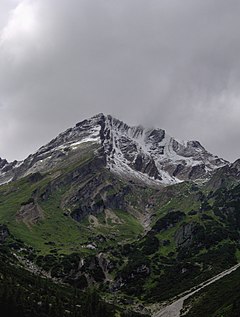| Gosau Group | |
|---|---|
| Stratigraphic range: Late Cretaceous-Eocene ~ | |
 Rocks of the Gosau Group exposed in the Imster Muttekopf | |
| Type | stratigraphic group |
| Sub-units |
|
| Overlies | Unconformity with folded and faulted Permian to Lower Cretaceous rocks |
| Thickness | 2,200–2,600 m (7,200–8,500 ft) |
| Location | |
| Coordinates | 47°36′N 13°30′E / 47.6°N 13.5°E |
| Approximate paleocoordinates | 32°06′N 15°36′E / 32.1°N 15.6°E |
| Region | Central Europe |
| Country | Austria Germany Slovakia |
| Extent | Gosau Basin, Limestone Alps |
The Gosau Group (German: Gosau-Gruppe) is a geological stratigraphic group in Austria, Germany and western Slovakia whose strata date back to the Late Cretaceous to Eocene.[1][2] It is exposed in numerous sporadic isolated basins within the Northern Calcareous Alps. It is divided into two subgroups, the Lower Gosau Subgroup which dates from the Turonian to Campanian, approximately 90 to 75 Ma and the Upper Gosau Subgroup which dates to the Santonian to Eocene, about 83.5 to 50 Ma. The formations within each subunit vary significantly between basins. The sequence is largely marine, but the Grünbach Formation represents a terrestrial deposit. Many of the units of the group are fossiliferous, typically providing marine fossils such as ammonites, though terrestrial remains including those of dinosaurs are known from the Grünbach Formation and Schönleiten Formation.
Among others, the following fossils have been described from the Gosau Group:[3][4]
| reptiles | |||||
|---|---|---|---|---|---|
| Genus | Species | Presence | Notes | Images | |
| Struthiosaurus | S. austriacus | Niederösterreich, Austria | [5] |  | |
| Mochlodon | M. suessi | A rhabdodontid iguanodont[5] |  | ||
| Rhadinosaurus | R. alcinus | Possible indeterminate ankylosaur remains[5] | |||
| "Crataeomus" | C. lepidophorus | Later found to be synonymous with Struthiosaurus austriacus[5] | |||
| C. pawlowitschii | Later found to be synonymous with Struthiosaurus austriacus in partim[5] | ||||
| "Danubiosaurus" | D. anceps | Later found to be indeterminate ankylosaurian and Struthiosaurus austriacus remains in partim[5] "Indeterminate fragments"[6] |
|||
| "Hoplosaurus" | H. ischyrus | Later found to be synonymous with Struthiosaurus austriacus[5] | |||
| "Leipsanosaurus" | L. noricus | Later found to be synonymous with Struthiosaurus austriacus[5] | |||
| "Pleuropeltus" | P. suessi | Later found to be synonymous with Struthiosaurus austriacus in partim[5] | |||
| "Megalosaurus" | M. pannoniensis | Later found to be indeterminate theropod remains[5] | |||
| Ornithocheiridae indet. | [7][8] | ||||
| Mollusca | |||||
| Genus | Species | Presence | Notes | Images | |
| "Trochactaeon" | T. conicus' | Nördliche Kalkalpen, Niederösterreich, Austria | Very common fossil, rock forming |  |
|
Color key
|
Notes Uncertain or tentative taxa are in small text; |